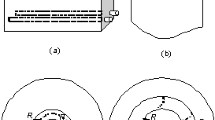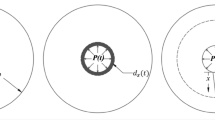Abstract
Corrosion-induced cracking of the concrete cover poses a serious problem for serviceability of reinforced concrete structures. In the paper a new analytical model for predicting cover cracking due to corrosion of reinforcing steel is presented. In the model, concrete around a corroding reinforcing bar is considered as a thick-walled cylinder subjected to uniform pressure at its inner surface, which represents expansion caused by corrosion products. The pressure leads to formation of radial cracks near the inner surface of the cylinder. In order to account for it, the cylinder is divided into two parts—a partially cracked inner cylinder and an uncracked outer one. Cracks in the inner cylinder are taken into account by gradually reducing its tangential stiffness along the radial direction. The model ensures a consistent stress-strain description within both inner and outer cylinders and complete continuity of stresses and strains on the boundary between the cylinders that distinguish it from previously published analytical models. The model is calibrated using available experimental data and then employed to estimate the amount of corrosion products penetrated into concrete pores before full cracking of the concrete cover. Estimates obtained in the paper show that this amount may be higher than has been assumed previously.










Similar content being viewed by others
References
Bentur A, Diamond S, Berke NS (1997) Steel corrosion in concrete. E&FN Spon, London
Val DV (2005) Effect of different limit states on life-cycle cost of RC structures in corrosive environment. J Infrastruct Syst 11(4):231–240. doi:10.1061/(ASCE)1076-0342(2005)11:4(231)
Alonso C, Andrade C, Rodriguez J, Diez JM (1998) Factors controlling cracking of concrete affected by reinforcement corrosion. Mater Struct 31:435–441. doi:10.1007/BF02480466
Bazant ZP (1979) Physical model for steel corrosion in concrete sea structures—application. J Struct Div 105(6):1155–1166
Liu Y, Weyers RE (1998) Modeling the time-to-corrosion cracking in chloride contaminated reinforced concrete structures. ACI Mater J 95(6):675–681
Li CQ, Melchers RE, Zheng JJ (2006) Analytical model for corrosion-induced crack width in reinforced concrete structures. ACI Struct J 103(4):479–487
Molina FJ, Alonso C, Andrade C (1993) Cover cracking as a function of rebar corrosion: part 2—numerical model. Mater Struct 26:532–548. doi:10.1007/BF02472864
Du YG, Chan AHC, Clark LA (2006) Finite element analysis of the effects of radial expansion of corroded reinforcement. Compos Struct 84:917–929. doi:10.1016/j.compstruc.2006.02.012
Lekhnitskii SG (1981) Theory of elasticity of an anisotropic body. Mir, Moscow
Williamson SJ, Clark LA (2000) Pressure required to cause cover cracking of concrete due to reinforcement corrosion. Mag Concr Res 52(6):455–467
Timoshenko SP, Goodier JN (1982) Theory of elasticity. McGraw-Hill, New York
Newhouse CD, Weyers RE (1996) Modeling the measured time to corrosion cracking. In: Techniques to assess the corrosion activity of steel reinforced concrete structures. ASTM STP 1276, American Society for Testing and Materials, pp 3–22
Chernin L, Val DV (2008) Prediction of cover cracking in reinforced concrete structures due to corrosion. In: Proceedings of the 1st international conference on construction heritage in coastal and marine environments (MEDACS08), LNEC, Lisbon, 28–30 January 2008 (CD-Rom)
El Maaddawy T, Soudki K (2007) A model for prediction of time from corrosion initiation to corrosion cracking. Cem Concr Compos 29:168–175. doi:10.1016/j.cemconcomp.2006.11.004
ABAQUS (2004) ABAQUS user’s manual, version 6.5. Hibbit-Karlson-Sorensen Inc, Pawtucket
Val DV, Chernin L, Stewart MG (2009) Experimental and numerical investigation of corrosion-induced cover cracking in reinforced concrete structures. J Struct Eng 135(4):376–385
Tepfers R (1979) Cracking of concrete cover along anchored deformed reinforcing bars. Mag Concr Res 31(106):3–12
Wang XH, Liu XL (2004) Modelling effects of corrosion on cover cracking and bond in reinforced concrete. Mag Concr Res 56(4):191–199. doi:10.1680/macr.56.4.191.36306
CEB (1993) CEB-FIP Model Code 1990. Bulletin d’Information No. 213/214. Comité Euro-International du Béton, Lausanne
Nielsen CV, Bićanić N (2002) Radial fictitious cracking of thick-walled cylinder due to bar pull-out. Mag Concr Res 54(3):215–221. doi:10.1680/macr.54.3.215.38797
Bhargava K, Ghosh AK, Mori Y, Ramanujam S (2006) Model for cover cracking due to rebar corrosion in RC structures. Eng Struct 28:1093–1109. doi:10.1016/j.engstruct.2005.11.014
Pantazopoulou SJ, Papoulia KD (2001) Modeling cover-cracking due to reinforcement corrosion in RC structures. J Eng Mech 127(4):342–351. doi:10.1061/(ASCE)0733-9399(2001)127:4(342)
George EA, Richard A, Ranjan R (1999) Special functions. Cambridge University Press, Cambridge
Suda K, Misra S, Motohashi K (1993) Corrosion products of reinforcing bars embedded in concrete. Corros Sci 35:1543–1549. doi:10.1016/0010-938X(93)90382-Q
Vu K, Stewart MG, Mullard J (2005) Corrosion-induced cracking: experimental data and predictive models. ACI Struct J 102(5):719–726
Petre-Lazar I (2000) Aging assessment of concrete structures submitted to steel corrosion (in French). PhD Thesis, Laval University, Quebec, Canada
CSA A23.3-94 (1994) Design of concrete structures. Canadian Standards Association, Rexadle, ON, Canada
Cabrera JG, Ghoddoussi P (1992) The effect of reinforcement corrosion on the strength of the steel/concrete bond. In: Proceedings of the international conference on bond in concrete, CEB, Riga, Latvia, 11–24 October
Andrade C, Alonso C, Molina FJ (1993) Cover cracking as a function of bar corrosion: part 1—experimental test. Mater Struct 26:453–464. doi:10.1007/BF02472805
Mangat PS, Elgarf MS (1999) Bond characteristics of corroding reinforcement in concrete beams. Mater Struct 32:89–97. doi:10.1007/BF02479434
El Maaddawy T, Soudki K, Topper T (2005) Long-term performance of corrosion-damaged reinforced concrete beams. ACI Struct J 102(5):649–656
Al-Harthy AS, Mullard J, Stewart MG (2007) Cracking in concrete due to corrosion of steel reinforcement. In: Proceedings of the 5th international conference on concrete under severe conditions: environment & loading (CONSEC’07), Tours, France (CD-Rom)
Marcotte TD, Hansson CM (2007) Corrosion products that form on steel within cement paste. Mater Struct 40:325–340. doi:10.1617/s11527-006-9170-4
Acknowledgement
This research was supported by the Bernstein Research Fund at the Technion.
Author information
Authors and Affiliations
Corresponding author
Rights and permissions
About this article
Cite this article
Chernin, L., Val, D.V. & Volokh, K.Y. Analytical modelling of concrete cover cracking caused by corrosion of reinforcement. Mater Struct 43, 543–556 (2010). https://doi.org/10.1617/s11527-009-9510-2
Received:
Accepted:
Published:
Issue Date:
DOI: https://doi.org/10.1617/s11527-009-9510-2




